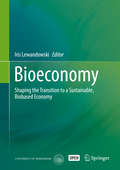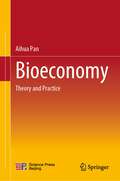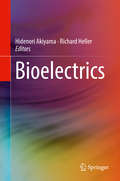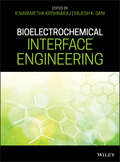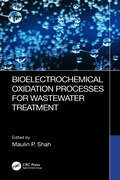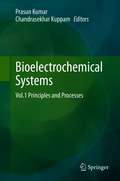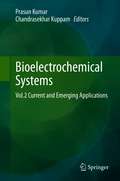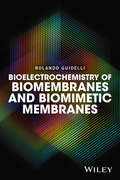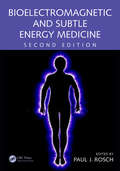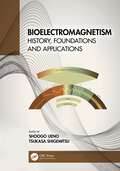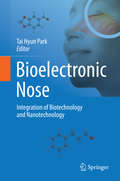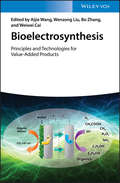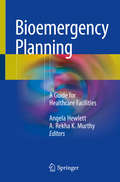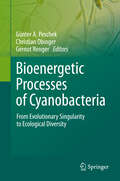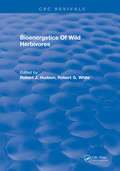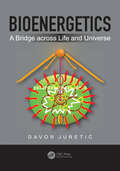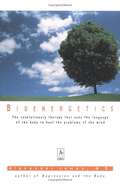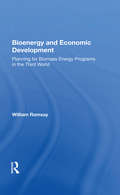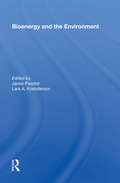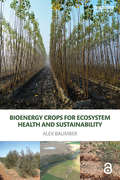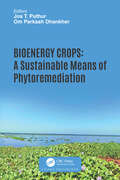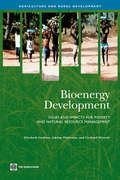- Table View
- List View
Bioeconomy: Shaping The Transition To A Sustainable, Biobased Economy (Economic Complexity And Evolution Ser.)
by Iris LewandowskiThis book is at the cutting edge of the ongoing research in bioeconomy and encompasses both technological and economic strategies to master the transformation towards a knowledge- and bio-based production system. The volume combines different international perspectives with approaches of the various fields of research. Bioeconomy is one of the future concepts of an economy which, while based on renewable biological resources, also predicts economic growth. Starting from a growth-economic as well as knowledge- and innovation-economic perspective the contributions give an overview of different existing patterns and cases and describe the basic prerequisites for the bioeconomy transformation. Therewith, the volume is a resource for experts and newcomers in the field of bioeconomy giving insight into the life cycle of bio-based products, detailing the latest advancements and how to turn them into economic growth.
Bioeconomy: Theory and Practice
by Aihua PanThis book focuses on the new concept of bioeconomy which collects the wisdom from life science, medicine and economics. lt finds the origins from ten existing theories, and also regards as “Pan's bioeconomy”. It has provided new methods for economic science research, opened up new fields for life science research, provided the right answer for China's economic miracle, filled the gap between materialism and idealism, and removed the fence between natural science and social science
Bioelectrics
by Richard Heller Hidenori AkiyamaThis book focuses on bioelectrics, a new multidisciplinary field encompassing engineering and biology with applications to the medical, environmental, food, energy, and biotechnological fields. At present, 15 universities and institutes in Japan, the USA and the EU comprise the International Consortium of Bioelectrics, intended to advance this novel and important research field. This book will serve as an introductory resource for young scientists and also as a textbook for use by both undergraduate and graduate students - the world's first such work solely devoted to bioelectrics.
Bioelectrochemical Interface Engineering
by Rajesh K. Sani R. Navanietha KrishnarajAn introduction to the fundamental concepts and rules in bioelectrochemistry and explores latest advancements in the field Bioelectrochemical Interface Engineering offers a guide to this burgeoning interdisciplinary field. The authors—noted experts on the topic—present a detailed explanation of the field’s basic concepts, provide a fundamental understanding of the principle of electrocatalysis, electrochemical activity of the electroactive microorganisms, and mechanisms of electron transfer at electrode-electrolyte interfaces. They also explore the design and development of bioelectrochemical systems. The authors review recent advances in the field including: the development of new bioelectrochemical configurations, new electrode materials, electrode functionalization strategies, and extremophilic electroactive microorganisms. These current developments hold the promise of powering the systems in remote locations such as deep sea and extra-terrestrial space as well as powering implantable energy devices and controlled drug delivery. This important book: • Explores the fundamental concepts and rules in bioelectrochemistry and details the latest advancements • Presents principles of electrocatalysis, electroactive microorganisms, types and mechanisms of electron transfer at electrode-electrolyte interfaces, electron transfer kinetics in bioelectrocatalysis, and more • Covers microbial electrochemical systems and discusses bioelectrosynthesis and biosensors, and bioelectrochemical wastewater treatment • Reviews microbial biosensor, microfluidic and lab-on-chip devices, flexible electronics, and paper and stretchable electrodes Written for researchers, technicians, and students in chemistry, biology, energy and environmental science, Bioelectrochemical Interface Engineering provides a strong foundation to this advanced field by presenting the core concepts, basic principles, and newest advances.
Bioelectrochemical Oxidation Processes for Wastewater Treatment
by Maulin P. ShahToxic and hazardous pollutant treatment of wastewater is a longstanding challenge faced in every region across the globe. Growing urbanization, combined with the increased use of detergent soaps, cleansing agents with new formulations, chemical fertilizers, and pesticides, has greatly added to the global wastewater pollution burden. Conventional methods of wastewater treatment are somewhat successful in decontamination, but these current techniques require more time and energy than newer, novel techniques. Bioelectrochemical oxidation systems (BEOSs), for example, have greatly aided in wastewater treatment sustainability and efficiency, and offer promising solutions for different types of energy recovery options. Bioelectrochemical Oxidation Processes for Wastewater Treatment examines the latest hybrid technologies utilizing algae, bacteria, and various other chemical agents, and discusses the major challenges in large-scale operations, as well as forward-looking techniques to make treatment processes even more sustainable in the future. It: Discusses the fundamentals of biological wastewater treatment and bioelectrochemical oxidation systems, as well as their advantages and limitations. Presents the recent trends and developments in bioelectrochemical oxidation systems for achieving environmentally sustainable wastewater treatment. Describes carbon capture and resource recovery from wastewater using bioelectrochemical oxidation systems. Addresses the challenges of large-scale implementation of bioelectrochemical oxidation systems in existing and new wastewater treatment plants.
Bioelectrochemical Systems: Vol.1 Principles and Processes
by Prasun Kumar Chandrasekhar KuppamThis book is the first in a two-volume set devoted to bioelectrochemical systems (BESs) and the opportunities that they may offer in providing a green solution to growing energy demands worldwide. In this first volume, established research professionals explain the underlying principles and processes of BESs, providing a thorough introduction to these systems before proceeding to address the roles of cathode catalysts and biocatalysts, biofilms, heterotrophic denitrification, and nanotechnology approaches. This volume forms a sound foundation for understanding the potential industrial applications of this technology, which include in particular the generation of high-value chemicals and energy using organic wastes. These applications are the focus of the second volume, where readers will find up-to-date information on microbial fuel cells and the use of microbial biofilm- and algae-based bioelectrochemical systems for bioremediation and co-generation of valuable chemicals. The book is designed for a broad audience, including undergraduates, postgraduates, energy researchers/scientists, policymakers, and anyone else interested in the latest developments in this field.
Bioelectrochemical Systems: Vol.2 Current and Emerging Applications
by Prasun Kumar Chandrasekhar KuppamThis book is the second in a two-volume set devoted to bioelectrochemical systems (BESs) and the opportunities that they may offer in providing a green solution to growing energy demands worldwide. While the first volume explains principles and processes, in this volume established research professionals shed light on how this technology can be used to generate high-value chemicals and energy using organic wastes. Bioelectricity is generated in microbial fuel cells (MFCs) under oxygen-depleted conditions, where microbial bioconversion reactions transform organic wastes into electrons. Dedicated chapters focus on MFCs and state of the art advancements as well as current limitations. In addition, the book covers the use of microbial biofilm- and algae-based bioelectrochemical systems for bioremediation and co-generation of valuable chemicals. A thorough review of the performance of this technology and its possible industrial applications is presented. The book is designed for a broad audience, including undergraduates, postgraduates, energy researchers/scientists, policymakers, and anyone else interested in the latest developments in this field.
Bioelectrochemistry Stimulated Environmental Remediation: From Bioelectrorespiration to Bioelectrodegradation
by Bin Liang Ai-Jie Wang Zhi-Ling Li Hao-Yi ChengThis book reviews the latest advances in the bioelectrochemical degradation of recalcitrant environmental contaminants. The first part introduces readers to the basic principles and methodologies of bioelectrochemical systems, electron-respiring microorganisms, the electron transfer mechanism and functional electrode materials. In turn, the second part addresses the bioelectrochemical remediation/treatment of various environmental pollutants (including highly toxic refractory organics, heavy metals, and nitrates) in wastewater, sediment and wetlands. Reactor configuration optimization, hybrid technology amplification and enhanced removal principles and techniques are also discussed.The book offers a valuable resource for all researchers and professionals working in environmental science and engineering, bioelectrochemistry, environmental microbiology and biotechnology.
Bioelectrochemistry of Biomembranes and Biomimetic Membranes
by Rolando GuidelliInvaluable to biochemists, biophysicists, and pharmacological scientists; this book provides insights into the essential principles required to understand why and how electrochemical and electrophysiological tools are fundamental in elucidating the mode of ion transport across biomembranes.* Describes the essential electrochemical basics required to understand why and how electrochemical and electrophysiological tools are fundamental in elucidating the mode of ion transport across biomembranes* Requires only basic physical chemistry and mathematics to be understood, without intermediate stumbling blocks that would discourage the reader from proceeding further* Develops contents in a step-by-step approach that encourages students and researchers to read from beginning to end
Bioelectromagnetic and Subtle Energy Medicine
by Davis LangdonBioelectromagnetic and Subtle Energy Medicine focuses on a wide variety of evidence-based bioelectromagnetic and subtle energy therapies for disorders ranging from cancer, cardiomyopathy, and Parkinson's disease to depression, anxiety, and pain. Since publication of the first edition more than a decade ago, there have been so many advances in these
Bioelectromagnetism: History, Foundations and Applications
by Shoogo UenoBioelectromagnetism has been gradually developing and expanding into a variety of fields in engineering, biomedical engineering, life science, medicine and biology. Bioelectromagnetism: History, Foundations and Applications provides an overview of the field and its developments; from its inception and growth through the twenty-first century, to the latest advances in electro- and magnetobiology and hazard evaluations of electromagnetic fields.It is organized into three sections, each focusing on specific regions of bioelectromagnetism. It begins with the foundations of the field and its history, with a chronological treatment of the major subjects in bioelectromagnetism. The relationship between atmospheric electromagnetic phenomena, geomagnetism and biological systems are presented. It then discusses the many benefits of bioelectromagnetism: electroreception, magnetic navigation, magnetic sense and magnetic responses of plants, birds, animals and humans. It then moves on to human health issues and the impact of bioelectromagnetism. It also provides practical guidance on how to set safety guidelines. Finally, it looks forward to the future prospects of the field based on the latest research in the field.In exploring both the history of the field and the latest developments in today’s research advances, this book provides a comprehensive and self-contained treatment on the subject, which will be a valuable reference for researchers in biophysics, medicine, electrical engineering and biomedical engineering.It can be used as a companion to the editor’s previously published books: Biomagnetics: Principles and Applications of Biomagnetic Stimulation and Imaging (9781482239201, 2016, CRC Press); and Bioimaging: Imaging by Light and Electromagnetics in Medicine and Biology (9780367203047, 2020, CRC Press).Key Features: Provides both a historical view of the field, along with the latest developments in the field Contains practical guidance for researchers on how to set safety guidelines for those working in the area Edited by authorities in the field, with chapter contributions from specialists
Bioelectronic Nose: Integration of Biotechnology and Nanotechnology
by Tai Hyun ParkThe "bioelectronic nose", the device which has a similar function to the human smell sensing system, can be realized by combining the olfactory cells or receptors with nanotechnology. In the last two decades, much has been learned about the smell sensing mechanism in biological systems. With knowledge about the biological olfactory system and the techniques for the expression of biological receptor proteins, we are able to utilize biological materials and systems to mimic the biological olfactory system. In addition to the advances in biological and biotechnological area, nanotechnology has progressed to a great degree. The bioelectronic nose is a good example of the integration of biotechnology and nanotechnology. This book describes basic biological sciences of the olfactory system, biotechnology for the production of olfactory biological elements, and nanotechnology for the development of various sensing devices. The purpose of this book is to provide the reader with a concept, basic sciences, fundamental technologies, applications, and perspectives of the bioelectronic nose.
Bioelectronics: Materials, Technologies, and Emerging Applications (Series in Materials Science and Engineering)
by Anuj Kumar Ram K. GuptaBioelectronics is emerging as a new area of research where electronics can selectively detect, record, and monitor physiological signals. This is a rapidly expanding area of medical research, that relies heavily on multidisciplinary technology development and cutting-edge research in chemical, biological, engineering, and physical science. This book provides extensive information on the (i) fundamental concepts of bioelectronics, (ii) materials for the developments of bioelectronics such as implantable electronics, self-powered devices, bioelectronic sensors, flexible bioelectronics, etc, and (iii) an overview of the trends and gathering of the latest bioelectronic progress. This book will broaden our knowledge about newer technologies and processes used in bioelectronics.
Bioelectrosynthesis (Advances in Biochemical Engineering/Biotechnology #167)
by Falk Harnisch Dirk HoltmannThis volume discusses both the latest experimental research in bioelectrosynthesis and current applications. Beginning with an introduction into the “electrification of biotechnology” as well as the underlying fundamentals, the volume then discusses a wide range of topics based on the interfacing of biotechnological and electrochemical reaction steps. It includes contributions on the different aspects of bioelectrochemical applications for synthesis purposes, i.e. the production of fine and platform chemicals based on enzymatically or microbially catalyzed reactions driven by electric energy. The volume finishes with a summary and outlook chapter which gives an overview of the current status of the field and future perspectives. Edited by experts in the field, and authored by a wide range of international researchers, this volume assesses how research from today’s lab bench can be developed into industrial applications, and is of interest to researchers in academia and industry.
Bioelectrosynthesis: Principles and Technologies for Value-Added Products
by Bo Zhang Aijie Wang Wenzong Liu Weiwei CaiIntroduces basic principles and mechanisms, covers new developments, and provides a different view of the main facets of bioelectrosynthesis Bioelectrosynthesis represents a promising approach for storing renewable energy or producing target chemicals in an energy-sustainable and low-cost way. This timely and important book systemically introduces the hot issues surrounding bioelectrosynthesis, including potential value-added products via bioelectrochemical system, reactor development of bioelectrosynthesis, and microbial biology on biofilm communities and metabolism pathways. It presents readers with unique viewpoints on basic principles and mechanisms along with new developments on reactor and microbial ecology. Beginning with a principle and products overview of bioelectrosynthesis, Bioelectrosynthesis: Principles and Technologies for Value-Added Products goes on to offer in-depth sections on: biogas production and upgrading technology via bioelectrolysis; organic synthesis on cathodes; chemical products and nitrogen recovery; external electron transfer and electrode material promotion; and the microbiology of bioelectrosynthesis. Topics covered include: hydrogen production from waste stream with microbial electrolysis cell; microbial electrolysis cell; inorganic compound synthesis in bioelectrochemical system; microbial growth, ecological, and metabolic characteristics in bioelectrosynthesis systems; microbial metabolism kinetics and interactions in bioelectrosynthesis system; and more. * Comprehensively covers all of the key issues of biolelectrosynthesis * Features contributions from top experts in the field * Examines the conversion of organic wastes to methane via electromethanogenesis; methane production at biocathodes; extracellular electron transport of electroactive biofilm; and more Bioelectrosynthesis: Principles and Technologies for Value-Added Products will appeal to chemists, electrochemists, environmental chemists, water chemists, microbiologists, biochemists, and graduate students involved in the field.
Bioemergency Planning: A Guide for Healthcare Facilities
by Angela Hewlett A. Rekha K. MurthyThis text gathers the weaknesses revealed during recent infections outbreaks and organizes them into a guide for combating the trends in emerging infections as they relate to hospital preparedness. As the first book to exclusively explore infectious emergencies, the text begins by reviewing potential pathogens and the clinical issues that may threaten hospital safety before delving into the best operational guidelines for commanding a staff under extreme circumstances, including incident command, communication, transport, maintenance, and a myriad of other topics that can remain manageable with proper protocol. Written by experts in the field, this text is the only one that offers the most effective clinical responses to a crisis at every level of care, including special population, laboratory techniques, care of the deceased, behavioral support, and medical documentation. The text concludes by focusing on the reality of care by introducing true examples from the field and the lessons gained from these cases.Bioemergency Planning is a vital resource for infectious disease specialists, hospitalists, epidemiologists, internal medicine physicians, nurses, social workers, public health officials, and all medical professionals who need to be prepared to respond to an infection outbreak.
Bioenergetic Processes of Cyanobacteria: From Evolutionary Singularity to Ecological Diversity
by Christian Obinger Gernot Renger Guenter A. PeschekThis publication is unique among a number of books on cyanobacteria because it focuses on the bioenergetics of these widespread organisms which are the evolutionary prerequisite for the development of all higher forms of life on our "blue" planet. The book primarily addresses questions of energy conversion by the fundamental bioenergetic processes: (oxygenic) photosynthesis, (aerobic) respiration, and (anaerobic) fermentation which uniquely occur together in these prokaryotic cells. Thermophilic cyanobacteria offer the most suitable material for high resolution structure analyses of Photosystem I and II and other electron transport complexes by X-ray crystallography (for example, at present the structure of Photosystem II at atomic resolution is only known for these organisms). These achievements during the last decade represent a milestone in our understanding of the complexes which are crucial for solar energy exploitation through photosynthetic water splitting. The present work represents an ambitious attempt to achieve the goal of a synoptic state-of-the-art picture by casting together the mosaics of detailed knowledge described by leading experts in the field. It contains 24 chapters written by 35 authors from Europe, USA, India and Japan. The book is aimed at reaching a broad audience ranging from students to experienced scientists. The editors wish all readers a pleasant and stimulating journey through the fascinating "world" of the bioenergetics of cyanobacteria and sincerely hope that this book will not only be of great value for the experts but also entice young people into this exciting research area with the aim to address successfully the challenging problems of high relevance that are still waiting for a satisfactory answer.
Bioenergetics Of Wild Herbivores
by Robert J. HudsonBioenergetics is an emerging discipline which offers a more profound understanding of the ecology, behaviour, and evolution of wild herbivores. Increasingly, bioenergetic principles have been applied in management since they provide insight into population dynamics and are relevant to manipulation of habitats and assessment of the impacts of resource development. Growing interest in the agricultural potential of wild herbivores has provided further impetus. In spite of this promise, there are few comprehensive syntheses of the concept and its application to wild herbivores. This volume attempts to fill this need. This book provides a great amount of detail but its expressive aim is to lead us to the whole animal, to a herd, to population as integral parts of an ecological entity which in turn is the result of evolutionary forces.The concept of this book promises the realization of an overdue change in the approach to bioenergetics, to nutrition and husbandry, and thus to the management of wild herbivores: the final emancipation from rules and views based primarily on domesticated herbivores or on experimental animals held under unnatural conditions, necessarily impending them behaviourally, physically, and psychically.
Bioenergetics: A Bridge across Life and Universe
by Davor JureticBioenergetics deals with the very first energy transformation steps performed by living cells. Increased dissipation is the primary effect of processing external energy packages. Enzyme-supported charge separation is the minor but essential outcome for maintaining life. This book explores the usefulness of dissecting the entropy production of enzymes involved in cellular defenses, fermentation, respiration, and photosynthesis, assuming that tightly regulated dissipation is the hallmark of life. Researchers, educators, and students of life sciences can find in this text many examples of how we can use the interdisciplinary approach to study cells' virtuoso ability to connect the microscopic to the macroscopic world. Each chapter is a self-contained unit with a glossary and selected references for further reading.
Bioenergetics: The Revolutionary Therapy That Uses The Language Of The Body To Heal The Problems Of The Mind (Compass Ser.)
by Alexander LowenBioenergetics is the revolutionary new therapy that uses the language of the body to heal the problems of the mind. This exciting body-mind approach to personality has a liberating and positive effect on emotional, physical, and psychic distress. Dr. Alexander Lowen, founder and prime mover of this fast-growing therapy, writes that increased joy and pleasure are possible in every day life through an understanding of how your body functions energetically: how it determines what you feel, think, and do. Dr. Lowen points out that lack of energy is the result of chronic muscular tensions, a condition caused by the suppression of feelings. <P><P>These tensions can be dissolved through the direct body work in bioenergetic exercise, which restores the potential for living a rich, full life. Dr. Lowen analyzes common physical ailments like headaches and lower back pain and shows how they too can be overcome by releasing the muscular tenstion that create them. Generously illustrated with line drawings of bioenergetic exercises, this book is sure to bring freedom, confidence, and pleasure to thousands of men and women. <P><P>"In this highly interesting and valuable attempt to restore the body to the mind, Dr. Alexander Lowen sets out in a practically useful way the principles of his new form of psychotherapy. Bioenergetics is destined to become widely influential."
Bioenergy And Economic Development: Planning For Biomass Energy Programs In The Third World
by William C RamsayBioenergy, a promising alternative for developing countries, is already a key resource (in the form of fuelwood, for example) in millions of households around the world. Third World planners are exploring new technologies and uses, including the production of biogas from wastes for household cooking, the burning of wood chips under boilers to produ
Bioenergy And The Environment
by Janos Pasztor Lars A. KristofersonThis book shows in detail that environmental consequences of very large increases in biomass utilization could be serious, if they were carried out without proper management. It provides knowledge of adverse and beneficial effects that bioenergy systems have on the environment to energy planners.
Bioenergy Crops for Ecosystem Health and Sustainability (Routledge Studies in Bioenergy)
by Alex BaumberThe growing of crops for bioenergy has been subject to much recent criticism, as taking away land which could be used for food production or biodiversity conservation. This book challenges some commonly-held ideas about biofuels, bioenergy and energy cropping, particularly that energy crops pose an inherent threat to ecosystems, which must be mitigated. The book recognises that certain energy crops (e.g. oil palm for biodiesel) have generated sustainability concerns, but also asks the question "is there a better way?" of using energy crops to strategically enhance ecosystem functions. It draws on numerous case studies, including where energy crops have had negative outcomes as well as well as cases where energy crops have produced benefits for ecosystem health, such as soil and water protection from the cropping of willow and poplar in Europe and the use of mallee eucalypts to fight salinity in Western Australia. While exploring this central argument, the volume also provides a systematic overview of the socio-economic sustainability issues surrounding bioenergy.
Bioenergy Crops: A Sustainable Means of Phytoremediation
by Jos T. PuthurBioenergy Crops: A Sustainable Means of Phytoremediation comprises a unique combination of topics related to the field of phytoremediation and bioenergy production. It highlights the future face of industries in phytoremediation and bioenergy production. The book deals with most promising plant and alga species for biomass production and phytoremediation. It deals with constructed wetlands, bioremediation and microbial fuel cells with case studies of phytoremediation and bioenergy production. The comprehensive knowledge on the dual aspects of hyperaccumulators in phytoremediation and bioenergy production guides graduates, post-graduates as well as researchers to know the latest updates in the field. Key Features:• Presents dual aspects of hyperaccumulators in phytoremediation and bioenergy production.• Highlights the future face of industries in phytoremediation and bioenergy production.• Focuses the promising candidates exploits as hyperaccumulator and biomass producers.• Explains the role of algae and microbes in bioremediation and bioenergy production.• Represents a comprehensive, up-to-date analysis in the field of phytoremediation as well as bioenergy production.
Bioenergy Development: Issues and Impacts for Poverty and Natural Resource Management
by Gerhard Dieterle Elizabeth Cushion Adrian WhitemanBioenergy has been critically important since our ancestors first used wood to cook their food and stay warm at night. Traditional forms of bioenergy, firewood and cow dung patties, remain primary fuel sources for many rural and poor people. More modern sources of bioenergy--including ethanol and biodiesel for transport and wood pellets for heating, among many others--offer great promise but generate great controversy. This book gives an overview of bioenergy developments. It examines the main issues and possible socioeconomic implications of these developments, as well as their potential impacts on land use and the environment, especially with respect to forests. The authors present an introduction to bioenergy, provide a background and overview of solid biomass and liquid biofuels, and examine the opportunities and challenges at the regional and country levels. They also examine potential impacts for specific types of bioenergy. 'Bioenergy Development' does not attempt to be definitive on such subjects as the impact of bioenergy on food prices, but it does suggest the tradeoffs that need to be examined when considering bioenergy policies. The authors offer five main findings: Solid biomass will continue to provide a principal source of energy and should not be overlooked. There will be major land-use implications resulting from bioenergy developments. It is critical to consider tradeoffs-including those related to poverty, equity, and the environment-when considering bioenergy policies. There is considerable potential for an increased use of forestry and timber waste as a bioenergy feedstock. The climate change impacts of bioenergy development are uncertain, and highly specific to location and feedstock.
